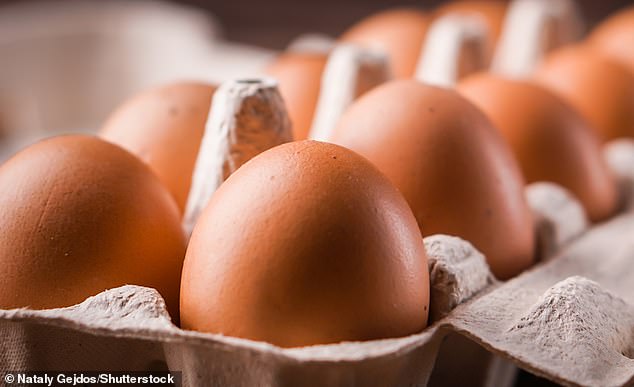As any shopper knows, eggs are sold in carboard cartons in neat little rows facing upwards.
But there’s nothing worse than getting them home and finding several of the little beauties cracked and ruined.
Now, a shock new study suggests a revolutionary new way for eggs to be packaged and stored.
In actual fact, they’d be better off lying on their side, pointing sideways rather than upwards, scientists reveal.
Lab experiments at Massachusetts Institute of Technology (MIT) show that raw chicken eggs are less likely to crack when dropped side-on.
Because the ‘equator’ of an egg can withstand more shock, packaging should be better designed to protect the two more breakable ends.
What’s more, if we were to pick them up horizontally out of a cardboard container, they’d be less likely to crack if we dropped them straight on the floor.
‘Eggs are tougher when loaded on their equator,’ say the MIT researchers in their paper, published today in Communications Physics.

Eggs are sold in carboard cartons facing up – but a new study suggests they’d be better stored lying on their side

Scientists say raw chicken eggs are more flexible around their equator – the fattest point across the width
The researchers conducted drop tests to compare how large raw chicken eggs break when orientated differently – horizontal on their equator, vertical on their sharp end, and vertical on their blunt end.
They tested 180 eggs in total – 60 each from three different heights, 0.31, 0.35 and 0.39 of an inch (8, 9, and 10 millimetres).
If researchers detected a fracture in the shell, the egg was classified as cracked.
Overall, they found a ‘statistically significant decrease’ in the likelihood that an egg breaks when oriented horizontally as opposed to vertically.
The number of eggs that cracked when impacted on their equator was lower than those impacted on their poles
And on average, eggs dropped vertically broke at lower drop heights (8.66mm) compared with those dropped horizontally (8.9mm).
More than half of the eggs dropped vertically from 8mm cracked (the end of the egg pointing downwards made no difference).
Meanwhile, less than 10 per cent of horizontally-dropped eggs cracked from the same height.

The scientists conducted a series of 180 drop tests to compare how chicken eggs break when orientated vertically or side-on

First study author Antony Sutanto at MIT is pictured taking measurements of eggs before performing the ‘dynamic egg drop tests’
A further 60 eggs were subjected to compression tests, which measured the force required to crack the eggs vertically and horizontally.
While 45 newtons of force was required to break the eggs in both orientations, the horizontally-loaded eggs could compress further before cracking.
Researchers think eggs are more flexible around their ‘equator’, and therefore able to absorb more energy in this orientation before breaking.
The results also challenge a widespread misassumption that an egg dropped vertically is less likely to crack.
‘We contest the commonly held belief that an egg is strongest when dropped vertically on its end,’ researchers say in their paper.
‘These results suggest an egg dropped on its equator can likely sustain greater drop heights without cracking.’
Overall, packaging that leaves the middle of the egg exposed more than the two ends could protect the product better.
The results also suggest the best way to crack a raw egg for cooking is to give it a tap on its top or bottom – not around the middle as commonly done.

A further 60 eggs were subjected to compression tests, which measured the force required to crack the eggs vertically and horizontally

The researchers say the strength of egg shells has implications beyond the chicken egg. Pictured are some eggs from the experiment in front of the Great Dome at MIT
However, the team admit that various material and geometric factors may contribute to the overall toughness of an egg.
In their paper, researchers say the strength of egg shells has implications beyond bird eggs.
In nature, shells act as a protective layers for soft-bodied organisms, turtle shells and sea shells, and the outer membranes of viruses and bacteria.
Future research could also apply the new findings to engineering scenarios, such as how structures respond to dynamic loads.
‘Insights on the mechanical failure of these structures may thus enable progress in a myriad of applications ranging from the design of protective equipment to drug delivery,’ the team say.
This article was originally published by a www.dailymail.co.uk . Read the Original article here. .

